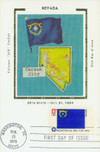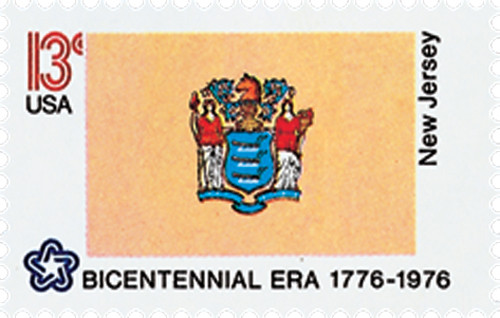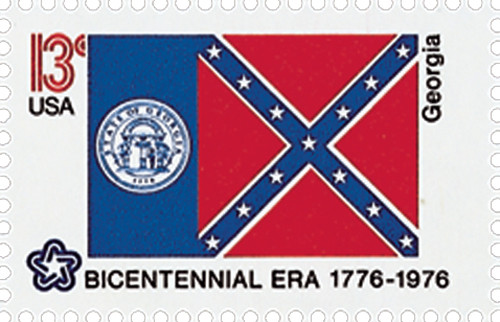
# 1668 - 1976 13c State Flags: Nevada
U.S. 1668
1976 Nevada
State Flags
American Bicentennial Series
• First time a sheet 50 had all different stamp designs
• Part of the American Bicentennial Series
Stamp Category: Commemorative
Series: American Bicentennial Series
Value: 13¢ First-class postage rate
First Day of Issue: February 23, 1976
First Day City(s): Washington, DC
Quantity Issued: 8,720,100 (panes of 50)
Printed by: Bureau of Engraving and Printing
Printing Method: Photogravure
Format: Sheet of 50
Perforations: 11
Why the stamp was issued:
The United States Postal Service celebrated the American Bicentennial with a full pane of the Union’s fifty state flags.
About the stamp design:
The Nevada State flag has a cobalt blue field in which the state’s emblem is in the upper right-hand corner. The emblem consists of a gold ribbon that says, “Battle Born,” on it which refers to reaching statehood during the American Civil War. Below the ribbon is a large silver star which points to the state’s nickname of Silver State and below the star is the state’s name. Below the star and Nevada is the state flower, two sprigs of green sagebrush with yellow flowers.
About the printing process:
Printed by the Bureau of Engraving and Printing on their seven-color Andreotti gravure press (601) which was their work horse for multicolored stamps.
About the American Bicentennial Series:
In the 1970s, America celebrated its 200th anniversary with hundreds of national events commemorating the heroes and historic events that led to our nation’s independence from Great Britain. The U.S. Postal Service issued 113 commemorative stamps over a six-year period in honor of the U.S. bicentennial, beginning with the American Revolution Bicentennial Commission Emblem stamp (U.S. #1432). As a group, the Bicentennial Series chronicles one of our nation’s most important chapters, and remembers the events and patriots who made the U.S. a world model for liberty.
Several of the stamps honored colonial life – craftsmen and communication. Other stamps honored important battles including Lexington and Concord, Bunker Hill, and Saratoga. Significant events such as the Boston Tea Party, the meeting of the First Continental Congress, and the Declaration of Independence were featured as well. The stamps also honored many significant people such as George Washington, Sybil Ludington, Salem Poor, and the Marquis de Lafayette.
Many of the stamps feature classic artwork. For instance, the set of four souvenir sheets picture important events recreated by noted artists such as John Trumbull. The Bicentennial Series also includes an important US postal first – the first 50-stamp se-tenant – featuring all 50 state flags. The format proved to be popular with collectors, and has been repeated many times since.
The American Bicentennial Series is packed with important US history – it tells the story of our nation’s fight for independence through stamps.
History the stamp represents:
On October 31, 1864, Abraham Lincoln admitted Nevada to the Union to aid in the Civil War.
American Indians may have lived in the Nevada region more than 20,000 years ago, making this area home to some of the earliest Indians in the United States. In southern Nevada, Indians left picture writing on rocks that date back thousands of years. Nevada tribes include the Pueblo, Mohave, Paiute, Shoshone, and Washoe.
Historians believe Francisco Garcés was the first white man to reach Nevada. In 1776, Garcés went through the region while traveling from New Mexico to California. William Wolfskill blazed the Old Spanish Trail from Santa Fe to Los Angeles. This route made it possible for people in Nevada to trade with the southeast.
A trapper, Joseph Walker, blazed an important trail along the Humboldt River from Nevada to California in 1833. When gold was discovered in 1848, thousands of people followed this trail west to stake a claim. From 1843 to 1845, Lieutenant John C. Frémont mapped Nevada with Kit Carson as his guide.
The United States acquired Nevada from Mexico at the end of the Mexican War in 1848. It was governed as part of a vast territory that included California, Utah, and parts of four other states. The Mormon leader Brigham Young organized the State of Deseret in 1849. Deseret included Utah, most of Nevada, and parts of other U.S. states. Young asked the federal government to admit Deseret to the Union. Instead, in 1850, Congress created the Utah Territory, which included Utah and most of Nevada, and named Young governor.
Starting in 1851, large numbers of Mormons began moving to the Carson Valley in Nevada. They established a trading post called Mormon Station for people traveling west to California to find gold. Mormon Station later became Genoa, the oldest permanent white settlement in Utah.
Carson Valley was organized as Carson County. However, non-Mormon citizens of Carson County did not want to be governed by Young. They petitioned Congress to make Carson County part of California. In 1857, Young asked Mormons in the area to move to Great Salt Lake due to fear of an attack by the federal government. Two years later, non-Mormons organized a separate government for Carson County and attempted to establish it as a distinct territory. However, the federal government refused to recognize the territory, due to its extremely limited population.
In 1859, a rich deposit of silver ore was discovered at the present site of Virginia City. Although other miners had discovered the silver, Henry Comstock took credit for finding the ore. Thus, this deposit became known as the Comstock Lode.
News of the discovery spread fast, and soon miners from California and the Eastern U.S. flocked to the area looking to strike it rich. Virginia City quickly became a thriving mining center.
The miners didn’t have an easy life. Provisions had to be shipped from California over the Sierra Nevada Mountains and were very expensive. Although some miners became millionaires, others found little or no wealth. Many of the miners were criminals, and lawlessness made the mining camps a dangerous place to live. Nevertheless, by 1860, Carson County’s mining camps held more than 6,700 people.
On March 2, 1861, President James Buchanan created the Nevada Territory. Two days later, President Abraham Lincoln took office. Lincoln named New York politician James W. Nye the territory’s first governor. The Civil War erupted before the territorial government could be established. Nevada’s rich silver resources gained importance during the war, as both sides needed wealth to pay for the expense of waging battle.
Most Nevadans favored the Northern cause. Lincoln was anxious to admit another state to the Union so that he would be able to pass his proposed slavery amendments to the U.S. Constitution. Despite the fact that Nevada did not have the required number of people to become a state, Nevadans held a convention to create a state constitution. The first convention, held in November 1863, met with failure. The second convention, held in July 1864, was a success. There was a rush to grant the territory statehood in order to help Lincoln’s re-election bid in 1864. To that end, the entire state constitution was sent to Washington, D.C., by telegraph. It was a process that took more than seven hours to transmit. Statehood was gained just eight days before the election, on October 31, 1864, with the Civil War still raging. This led to Nevada’s nickname “Battle Born,” which is featured on the state flag.
U.S. 1668
1976 Nevada
State Flags
American Bicentennial Series
• First time a sheet 50 had all different stamp designs
• Part of the American Bicentennial Series
Stamp Category: Commemorative
Series: American Bicentennial Series
Value: 13¢ First-class postage rate
First Day of Issue: February 23, 1976
First Day City(s): Washington, DC
Quantity Issued: 8,720,100 (panes of 50)
Printed by: Bureau of Engraving and Printing
Printing Method: Photogravure
Format: Sheet of 50
Perforations: 11
Why the stamp was issued:
The United States Postal Service celebrated the American Bicentennial with a full pane of the Union’s fifty state flags.
About the stamp design:
The Nevada State flag has a cobalt blue field in which the state’s emblem is in the upper right-hand corner. The emblem consists of a gold ribbon that says, “Battle Born,” on it which refers to reaching statehood during the American Civil War. Below the ribbon is a large silver star which points to the state’s nickname of Silver State and below the star is the state’s name. Below the star and Nevada is the state flower, two sprigs of green sagebrush with yellow flowers.
About the printing process:
Printed by the Bureau of Engraving and Printing on their seven-color Andreotti gravure press (601) which was their work horse for multicolored stamps.
About the American Bicentennial Series:
In the 1970s, America celebrated its 200th anniversary with hundreds of national events commemorating the heroes and historic events that led to our nation’s independence from Great Britain. The U.S. Postal Service issued 113 commemorative stamps over a six-year period in honor of the U.S. bicentennial, beginning with the American Revolution Bicentennial Commission Emblem stamp (U.S. #1432). As a group, the Bicentennial Series chronicles one of our nation’s most important chapters, and remembers the events and patriots who made the U.S. a world model for liberty.
Several of the stamps honored colonial life – craftsmen and communication. Other stamps honored important battles including Lexington and Concord, Bunker Hill, and Saratoga. Significant events such as the Boston Tea Party, the meeting of the First Continental Congress, and the Declaration of Independence were featured as well. The stamps also honored many significant people such as George Washington, Sybil Ludington, Salem Poor, and the Marquis de Lafayette.
Many of the stamps feature classic artwork. For instance, the set of four souvenir sheets picture important events recreated by noted artists such as John Trumbull. The Bicentennial Series also includes an important US postal first – the first 50-stamp se-tenant – featuring all 50 state flags. The format proved to be popular with collectors, and has been repeated many times since.
The American Bicentennial Series is packed with important US history – it tells the story of our nation’s fight for independence through stamps.
History the stamp represents:
On October 31, 1864, Abraham Lincoln admitted Nevada to the Union to aid in the Civil War.
American Indians may have lived in the Nevada region more than 20,000 years ago, making this area home to some of the earliest Indians in the United States. In southern Nevada, Indians left picture writing on rocks that date back thousands of years. Nevada tribes include the Pueblo, Mohave, Paiute, Shoshone, and Washoe.
Historians believe Francisco Garcés was the first white man to reach Nevada. In 1776, Garcés went through the region while traveling from New Mexico to California. William Wolfskill blazed the Old Spanish Trail from Santa Fe to Los Angeles. This route made it possible for people in Nevada to trade with the southeast.
A trapper, Joseph Walker, blazed an important trail along the Humboldt River from Nevada to California in 1833. When gold was discovered in 1848, thousands of people followed this trail west to stake a claim. From 1843 to 1845, Lieutenant John C. Frémont mapped Nevada with Kit Carson as his guide.
The United States acquired Nevada from Mexico at the end of the Mexican War in 1848. It was governed as part of a vast territory that included California, Utah, and parts of four other states. The Mormon leader Brigham Young organized the State of Deseret in 1849. Deseret included Utah, most of Nevada, and parts of other U.S. states. Young asked the federal government to admit Deseret to the Union. Instead, in 1850, Congress created the Utah Territory, which included Utah and most of Nevada, and named Young governor.
Starting in 1851, large numbers of Mormons began moving to the Carson Valley in Nevada. They established a trading post called Mormon Station for people traveling west to California to find gold. Mormon Station later became Genoa, the oldest permanent white settlement in Utah.
Carson Valley was organized as Carson County. However, non-Mormon citizens of Carson County did not want to be governed by Young. They petitioned Congress to make Carson County part of California. In 1857, Young asked Mormons in the area to move to Great Salt Lake due to fear of an attack by the federal government. Two years later, non-Mormons organized a separate government for Carson County and attempted to establish it as a distinct territory. However, the federal government refused to recognize the territory, due to its extremely limited population.
In 1859, a rich deposit of silver ore was discovered at the present site of Virginia City. Although other miners had discovered the silver, Henry Comstock took credit for finding the ore. Thus, this deposit became known as the Comstock Lode.
News of the discovery spread fast, and soon miners from California and the Eastern U.S. flocked to the area looking to strike it rich. Virginia City quickly became a thriving mining center.
The miners didn’t have an easy life. Provisions had to be shipped from California over the Sierra Nevada Mountains and were very expensive. Although some miners became millionaires, others found little or no wealth. Many of the miners were criminals, and lawlessness made the mining camps a dangerous place to live. Nevertheless, by 1860, Carson County’s mining camps held more than 6,700 people.
On March 2, 1861, President James Buchanan created the Nevada Territory. Two days later, President Abraham Lincoln took office. Lincoln named New York politician James W. Nye the territory’s first governor. The Civil War erupted before the territorial government could be established. Nevada’s rich silver resources gained importance during the war, as both sides needed wealth to pay for the expense of waging battle.
Most Nevadans favored the Northern cause. Lincoln was anxious to admit another state to the Union so that he would be able to pass his proposed slavery amendments to the U.S. Constitution. Despite the fact that Nevada did not have the required number of people to become a state, Nevadans held a convention to create a state constitution. The first convention, held in November 1863, met with failure. The second convention, held in July 1864, was a success. There was a rush to grant the territory statehood in order to help Lincoln’s re-election bid in 1864. To that end, the entire state constitution was sent to Washington, D.C., by telegraph. It was a process that took more than seven hours to transmit. Statehood was gained just eight days before the election, on October 31, 1864, with the Civil War still raging. This led to Nevada’s nickname “Battle Born,” which is featured on the state flag.


















